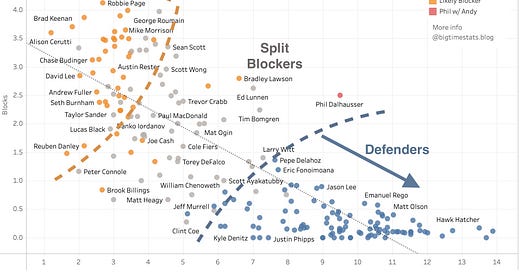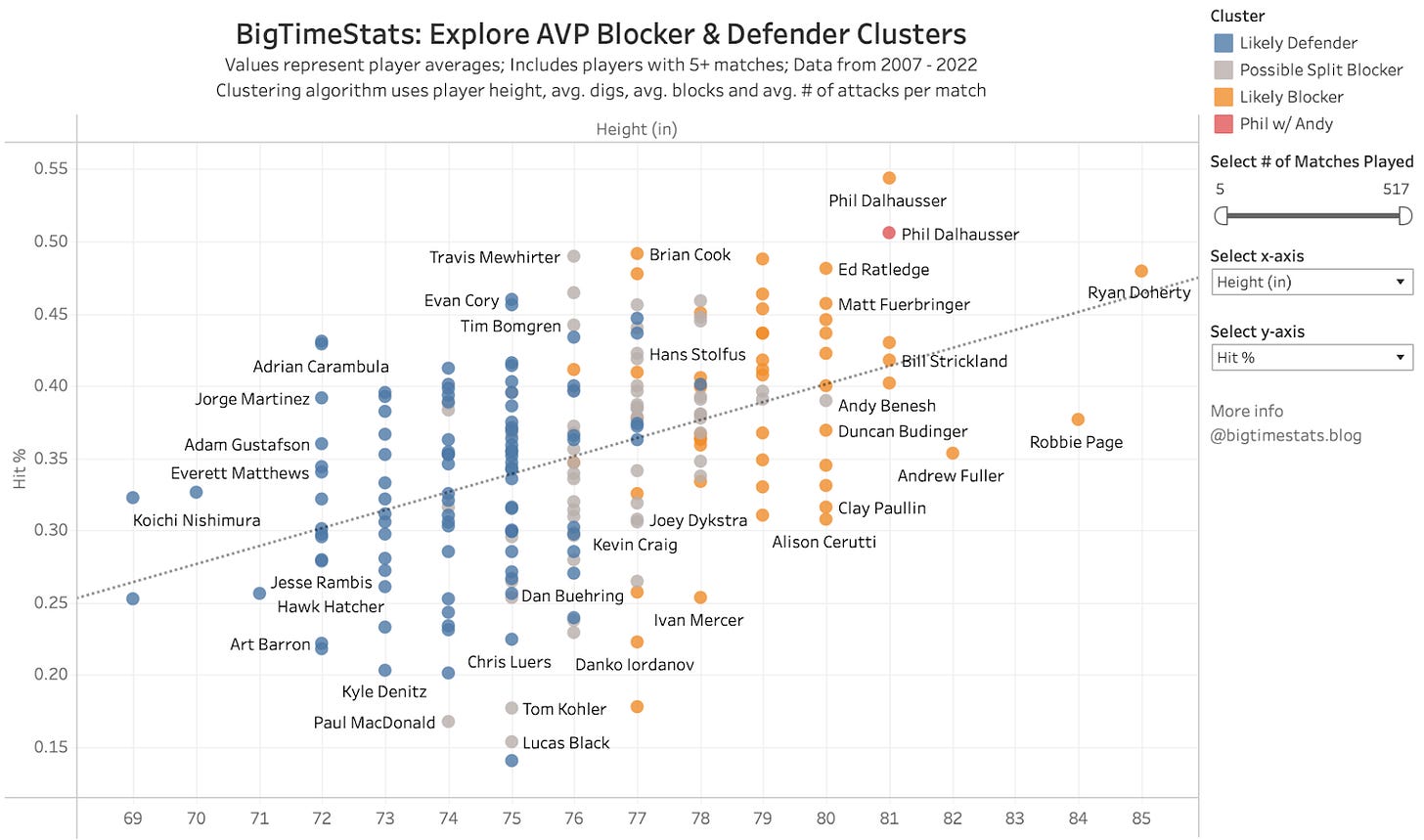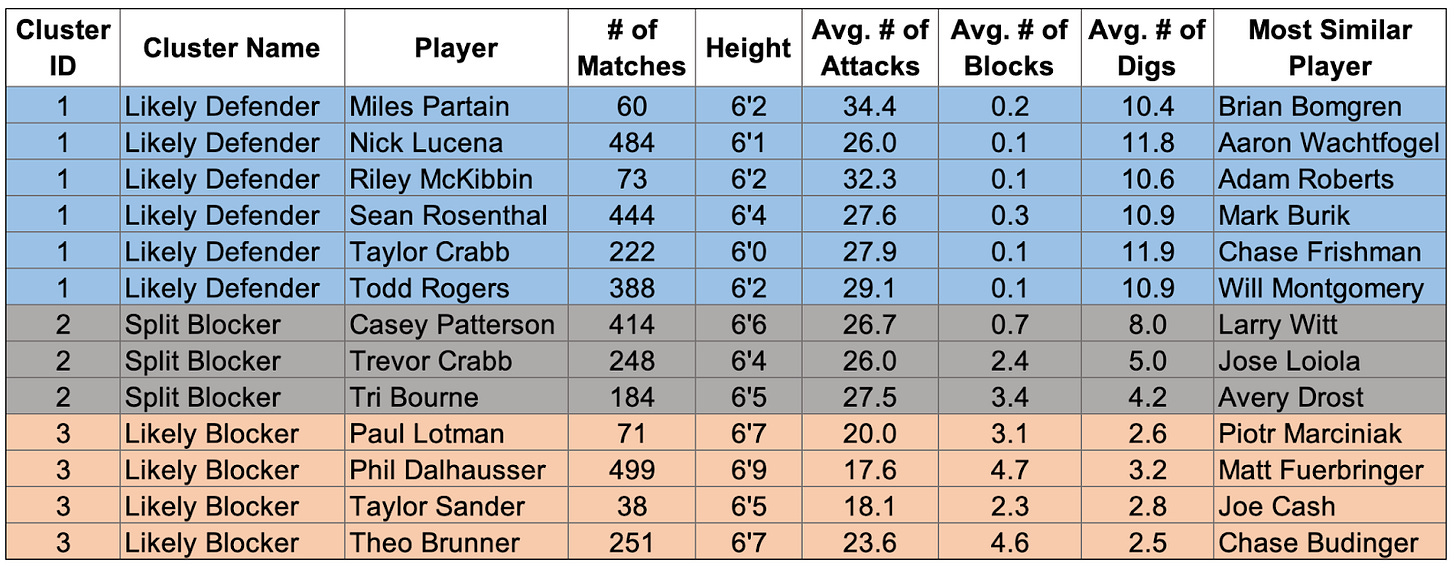Phil Dalhausser - AVP's Best Defender?
Explore a new interactive view comparing AVP defenders and blockers
Phil Dalhausser is known for being one of the best full-time blockers on the AVP and world tours. He has even been awarded AVP best blocker in 2015, 2016, 2017, and 2019.
In 2022, however, Phil split defending duties with Andy Benesh in the AVP Austin Open. As a defender, Phil made some ridiculous plays that only seasoned players like Taylor Crabb or Nick Lucena are known for. Phil got 14 digs against Trevor Crabb and Tri Bourne in the semi-finals, even digging a high line roll shot on the very first point before cruising on to take the title.
This made me wonder, how does Phil stack up against other defenders? I dug into the data to find out.
A Small Problem
In order to baseline Phil’s performance as a defender, I wanted to compare his defensive digging stats to other known defenders.
However, there isn’t a dataset that labels players as either a blocker, defender, or split blocker. Even though it’s pretty easy to determine what position someone plays just by watching their match, it’s not a scalable way to classify everyone.
As a data scientist, I took this as a challenge and wanted to create my own labels for further analysis.
Clustering Players to Find Hidden Patterns
Clustering allows you to group together similar data points based on certain inputs.
Using an unsupervised clustering algorithm similar to k-means, I generated 3 groups of players: likely blockers, likely defenders, and possible split blockers. The algorithm works to find the optimal grouping of players to maximize the similarity of players within the same cluster.
I used the player height and average # of attacks, digs, and blocks per match as inputs based on my intuition for what might be relevant for effective clustering. The data is from 2007 - 2022 AVP tournaments that contain match stats.
I added the blocker and defender labels to each cluster id after visualizing the outputs below.
Cluster Output
After getting the clustering output, I created an interactive dashboard in Tableau to visualize the results. Players in the cluster between Likely Defender and Likely Blocker were labeled as “Possible Split Blockers”.
Although the algorithm is based on 4 variables, you can visualize the blocker & defender groupings in 2d across all available match stats, including aces, errors, and hitting percentage to find unique patterns and insights.
“Likely Blockers” are generally defined by being taller, having less attacks, more blocks, and less digs.
“Likely Defenders” were generally shorter, had more attacks, less blocks and more digs.
Explore and update the metrics on the x & y-axis to come up with unique views!
The 3 clusters can be represented by the central or typical example players below:
Notable Players:
Likely Blockers: Phil Dalhausser, Taylor Sander, Theo Brunner
Possible Split Blockers: Trevor Crabb, Tri Bourne, Casey Patterson*
Possible Defenders: Taylor Crabb, Miles Partain, Nick Lucena
* Casey Patterson is labeled as a possible split blocker and has mostly defended in his recent matches. However, footage from earlier in his career does show him blocking, likely why he gets slightly less than 1 block per match when averaged out over 15 years.
So Is Phil Dalhausser the AVP’s Best Defender?
Based on Phil’s 5 matches with Andy Benesh at the 2022 Austin Open, he is the clear best defender among other “Split Blockers”.
He averaged 9.5 digs per match in Austin, giving him the most digs of any other split blocker like Trevor Crabb, Tri Bourne, and Tim Bomgren. However, it’s important to keep in mind Phil’s stats are averaged over a shorter period of time.
Among “Likely Defenders”, Phil is right in the middle of the pack. Full time defenders like John Hyden and Taylor Crabb average around 11-12 digs per match so Phil is not far off. Karch Kiraly averaged almost 14 digs per match based on 42 recorded matches since 2007, showing how he is one of the all time greats.
Phil is an extremely talented player that can play all the positions. Along with great defense, he’s an amazing setter as he doesn’t get served often and also gets aces when it matters most.
Other interesting use cases
You can use the available stats to visualize the relationship between any two metrics. In this example, there is a positive correlation between a player’s height (x-axis) and their corresponding hitting percentage (y-axis, signifying hitting efficiency). Likely blockers are typically clustered towards the top right end of the distribution, signifying a higher hitting efficiency and being taller vs. defenders.
Post favorite views in the comments!
Finding Similar Players
We can also use our unique clustering algorithm to find the most similar players to each other. It uses the available data to find the player with the most similar height + match stats to the selected player.
Table below highlights the top players on the AVP
* Similar players are not necessarily symmetric since player “A” can be closest to “B” but B can be closest to C (e.g. Matt Fuerbringer is Phil Dalhausser’s most similar player, but Ricardo Santos is most similar to Fuerbringer)
It’s interesting to note, for example, that Jose Loiola has the most similar stats to Trevor Crabb and ended up coaching Trever and Tri Bourne. I wonder how the similarity translated to a positive coaching relationship since Jose likely faced the same kinds of challenges as Trevor.
Thanks for reading! I make this content in my free time to showcase how data can be used to better understand the sport I love to play. Drop me a comment if you found this helpful or if there is anything you’d like me to look into!










What are PC1 and PC2? Are they player clusters you've made? I notice that both Phils have the same PC1 and PC2. PC2 is nicely correlated with Attacks and Kills but not as much for the others. PC1 is really separating the diggers and blockers but PC2 is not.
Also, while watching that Austin video, it was clear that the wind was a big advantage. It might be interesting to infer wind advantage by determining the total points won on each side. Then you could characterize players on ability to play with and against the wind advantage. There are so many opportunities for playing with various combinations. Thank you for starting this blog.